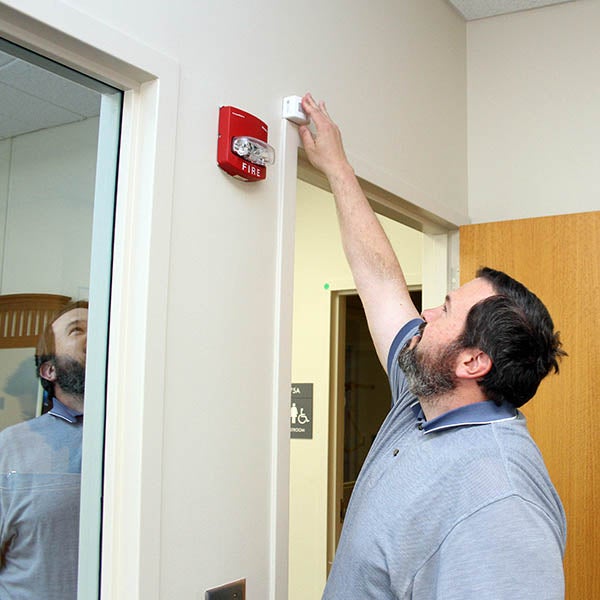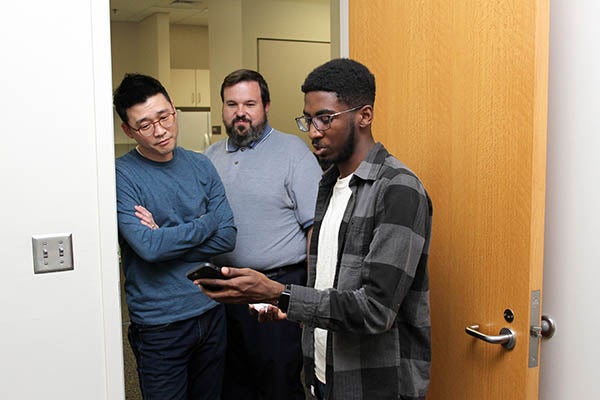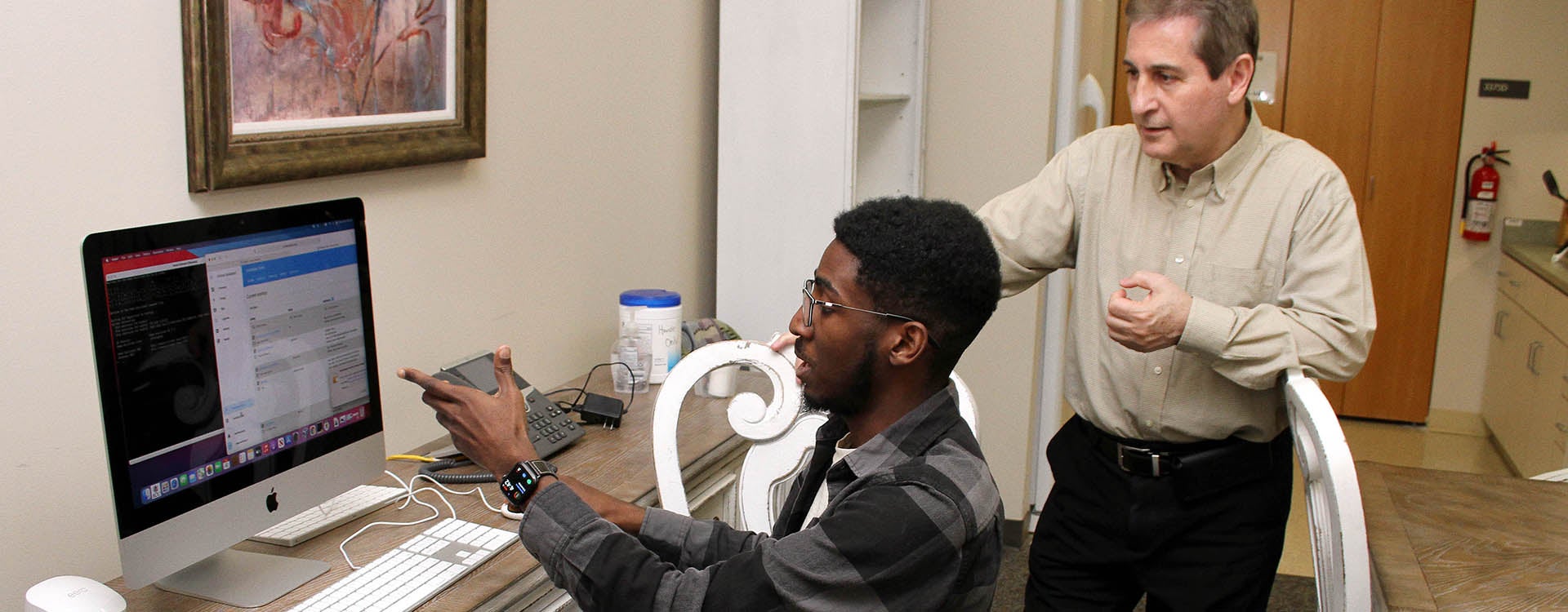SMART HEALTH
Project designed to support care for older adults
Helping older adults with their health while allowing them to live independently is the goal of a project led by a multidisciplinary team of researchers at East Carolina University.
Called “Intelligent Homecare Provisioning for Older Adults,” the project initiated by Dr. Kamran Sartipi in Department of Computer Science will develop and evaluate the use of smart home technologies as part of an at-home intelligent decision support system that would capture the behaviors of older adults. This would provide off-site health care providers with actionable information about the conditions of their patients.

Dr. Ricky Castles installs a motion sensor in a Department of Occupational Therapy apartment lab in the Health Sciences Building.
“It’s not a substitute for a health care provider, but it works as an early alert system to the health care provider so they can have a conversation with their patient,” said Dr. Ricky Castles, associate professor in the Department of Engineering and one of those working on the project. “The hope is that the sensors allow earlier intervention while allowing people to comfortably live in their home environment where they are more familiar rather than having the expense of living in assisted living or having more advanced nursing care.”
Through the integration of available technologies, short-term health monitoring and long-term behavior pattern analysis of the older adults would be conducted. With a 24/7 data collection and monitoring system, the need for health care providers to see patients in an office setting and the subsequent cost would both decrease. The data could also provide early detection of problems, setting the stage for earlier treatment and better recovery while reducing the chances of hospitalization that could result in costly bills.
The research team also includes Dr. Young Joo Kim, associate professor and graduate program director in the Department of Occupational Therapy, Dr. Donna Roberson, associate professor in the College of Nursing, and Dr. Ricky Watson, assistant residency director and clinical assistant professor in the Department of Family Medicine.
“There are people involved from all different departments — computer science, engineering, occupational therapy, nursing, family medicine — and everyone comes with all different kinds of expertise,” Kim said. “I think that makes this project and what we’re doing really strong.”
The first phase of the project called vNurse (virtual nurse) involves the collection of sensor data for analysis. Cloud computing, radio frequency identification (RFID), Apple HomePod and Fitbit watches are all part of the technology that is used to collect the data.
The team, which includes junior computer science major Braxton Chambers, recently went to the Lab for the Skills of Living in ECU’s Health Sciences Building to work on the project. The lab is essentially an apartment with bedroom, living room, kitchen and bathroom. The team installed the sensors in the room and began testing them with the use of a cell phone and laptop computer.

From left, Dr. Young Joo Kim, Dr. Ricky Castles and computer science student Braxton Chambers check for connections to smart devices designed to support the health care of older adults in a Department of Occupational Therapy apartment lab.
“We’re going to apply artificial intelligence learning to collect the behaviors of the people,” Sartipi said. “We’ll see how they change their behavior throughout the months. With the analytics, we’ll be able to see some patterns, and with doctors and nurses collaborating, we’ll be able to identify any major change in their behavior so that we can intervene and prevent hospitalization.”
RFIDs can detect the target person among other residents at home, and motion sensors could indicate when that person becomes less active. Sensors placed under a mattress could be used to detect sleep deprivation, and Fitbits could point to changes in resting heart rate that could indicate fitness problems. Sensors could also be used to determine if a person is taking the proper medication doses at the right time.
The technology is designed to be less intrusive than having assisted care, providing a sense of independence to the patient while also providing health care providers accurate information of that patient’s activity and condition. The data doesn’t diagnose specific problems, but changes in that data could indicate a problem or a patient’s improvement.
“Just because someone’s activity level declines, that could be for a variety of reasons,” Castles said. “That’s where you need a health care provider to come in. If the data is consistent, people are going about their routines, that could be an indication that everything is going great.”
Kim said the use of multiple devices would provide health care providers with a good overview.
“I think the beauty of this project is you get a single set of data from all different views,” he said. “It’s not just a Fitbit watch with the activity level. It’s not just a motion sensor, but all together, you can have more intelligence about a patient’s health.”
And the sensors won’t be in the way.
“A big goal of this project is to maintain privacy and to be unobtrusive,” Castles said. “The sensors are intended to be mounted in locations where they are not really obvious and not in the way. We’re not installing cameras. We’re not watching people because that’s obviously something that is going to make them uncomfortable.”
In the lab, Chambers spent about an hour installing the equipment and testing it. He said he was proud to work on the project.
“This is my first job. I never had a job before this,” he said. “I’m hoping to go into data science and artificial intelligence, but I may stay in research as well because I really enjoy doing research and learning new things because this is technology that will continue to grow over time.”
He said working on the project gave him some good organizational skills and an appreciation for the project’s importance.
“I’ve gained a lot,” he said. “I’ve gained how important projects like this are to the real world. I think this project can be something that will be looked at a lot in the future.”
The second phase of the project would be to install the sensor network in the residences of volunteers in Cypress Glen Retirement Community in Greenville to perform pilot projects.
“The safety, privacy and convenience of the volunteer residents will be of prime importance to the project,” Sartipi said.
The team plans to use these early test results to submit a proposal to the National Science Foundation in the fall to seek funding support for the ongoing project.

Dr. Kamran Sartipi and computer science student Braxton Chambers check smart devices in a Department of Occupational Therapy apartment lab in the Health Sciences Building.
